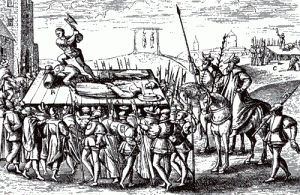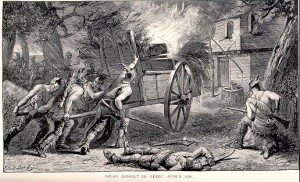The body was found– either charred, or still ablaze, depending on the imagination of the local beat writer– just off the road near Cranford, New Jersey. Discovered in a snow bank, the corpse had a hole blown in its skull. The woman’s clothes had been soaked in gasoline.
No one, however, knew who she was. The morgue stored an unidentified body for six weeks.
Big Guns from Pinkerton
Baffled NJ detectives needed help. They enlisted the aid of the Pinkerton National Detective Agency, whose founder had foiled The Baltimore Plot to assassinate Abraham Lincoln, and whose agents had previously been hired to hunt down Jesse James, Butch Cassidy, and the Sundance Kid. Agent Wagner joined the investigation.
The remains were discovered on February 23, 1929, but even with Pinkerton’s on the case, they remained unidentified. On April 9th, that changed.
Police from Greenville, Pennsylvania telegrammed to Wagner that the victim might be Mildred Mowry. Wagner met with her associates. They provided him with a bundle of letters from a doctor, Richard M. Campbell whom, they said, Mowry had married. Two days later, NJ police arrested not “Richard M. Campbell,” not “Henry Colin Campbell,” but “Richard Henry Campbell,” all of which were aliases for the man born as Henry Campbell Close.
Close confessed to murder after an hour of questioning by Wagner, who then spent two months developing a case for the prosecution and uncovering the story of a truly bizarre little man responsible for one of the “most revolting murders in New Jersey annals,” one which inspired a rash of gruesome copy-cat “torch murderer” kills.
The Victim
Mildred Mowry was no “little old lady from Peoria”– she lived in PA. Other than that, Mowry, a middle-aged nurse, fit the cliché. Today, she might answer emails from would-be Nigerian Kings or continuously update her profile at eHarmony but, in those days, childless, widowed, she read “Miss Lonelyhearts” and chose a matchmaking agency.
Campbell used the same agency for years, although he still lived with his wife of over a decade, who would testify that they and their three children lived in “perfect harmony.” Henry Colin Campbell scoured bars and agency listings, hunting for his perfect prey: a widow, childless, with money. Such was Mowry, he thought.
A Killer Marriage
Debt led Close to the notion of bilking a bigamous wife for her savings. He ad been trying to lure another wife for years. After he married Mowry, the bride returned to her PA home, but first deposited money in a savings account jointly owned with the man she thought she married: Doctor Richard M. Campbell, of Baltimore.
Mowry returned to PA, presumably expecting to move to Baltimore soon thereafter. Police did, in fact, match records between a real estate transaction in Baltimore and Close’s purchase of a house in NJ.
Tit for tat: Close selected Mowry for her “small fortune” but soon found that her nest egg was but $1000.
 He picked her up in PA for a drive to Philadelphia. Their car had engine trouble. They had to drive until very late in the evening. His wife grew tired. She “kept pestering me,” he said in his confession, to “turn the car around and stop somewhere for the night. I suddenly decided to get rid of her because I could not support two homes. She was dozing in the back seat and I shot her in the head, took the body out of the car, and set fire to it.”
He picked her up in PA for a drive to Philadelphia. Their car had engine trouble. They had to drive until very late in the evening. His wife grew tired. She “kept pestering me,” he said in his confession, to “turn the car around and stop somewhere for the night. I suddenly decided to get rid of her because I could not support two homes. She was dozing in the back seat and I shot her in the head, took the body out of the car, and set fire to it.”
Character Revelations
At trial, the Court learned more about Henry Collin Campbell.
He wasn’t a doctor, although he played one in Montclair, NJ. Criminal records revealed that “Doctor” Close had operated a “private insane asylum.” A Columbia graduate, he’d been a civil engineer, a writer, an educator, and a well-paid advertising man. He adored his children, and “never used a cross word,” according to his wife Rosalee, who had no idea that police believed he had as many as three other wives, at least one of whom died under mysterious circumstances.
He loved grotesque dolls; they were strewn all around his room. For grand larceny, he served six years in Sing Sing prison. Testifying, he claimed that his “mind was wracked” from morphine abuse. He was suicidal.
Francis A. Gordon, Campbell’s attorney, mounted a defense based on his client’s drug addiction, insanity, and amnesia. Defense retained Dr. Ambrose Dowd, a psychologist from the NJ State Board of Institutions, with support from a skilled roentgenologist. Prosecution argued that Campbell was sane, sober, and his memory was fine. He had, after all, lucidly confessed.
The jury spent just four hours in deliberation. Henry Colin Campbell, the Torch Murderer, was sentenced to death.
Rosalee was the last wife to see him. She spent a tender half hour with Close on the day of his electrocution.
Selected Sources
“Campbell Sentenced to Die on July 15.” Lewiston Daily Sun 14 June 1929: 19. Google News. Web. 6 Apr. 2010.
“Defense Prepared- Alienist Retained by Attorney for Campbell.” Pittsburgh Press 18 Apr. 1929: 2. Google News. Web.
“Henry Colin Campbell Trial: 1929- Fit to Plead.” Law Library – American Law and Legal Information. Jrank.org. Web. 8 Apr. 2010.
“Henry Colin Campbell Trial: 1929- Scathing Prosecution Attack.” Law Library – American Law and Legal Information. Jrank.org. Web. 8 Apr. 2010.
James, Christian, Daniel Lewis, and Ariel W. Simmons. Pinkerton’s National Detective Agency. Bethesda, MD: UPA Collection from LexisNexis, 2007. Print.
Sanders, Bruce. Murder in Lonely Places. London: Jenkins, 1960. Print.
“Torch Slayer Is Guilty; to Die in Chair.” Daily Times [Beaver, PA] 14 June 1929: 1. Google News. Web. 5 Apr. 2010.











